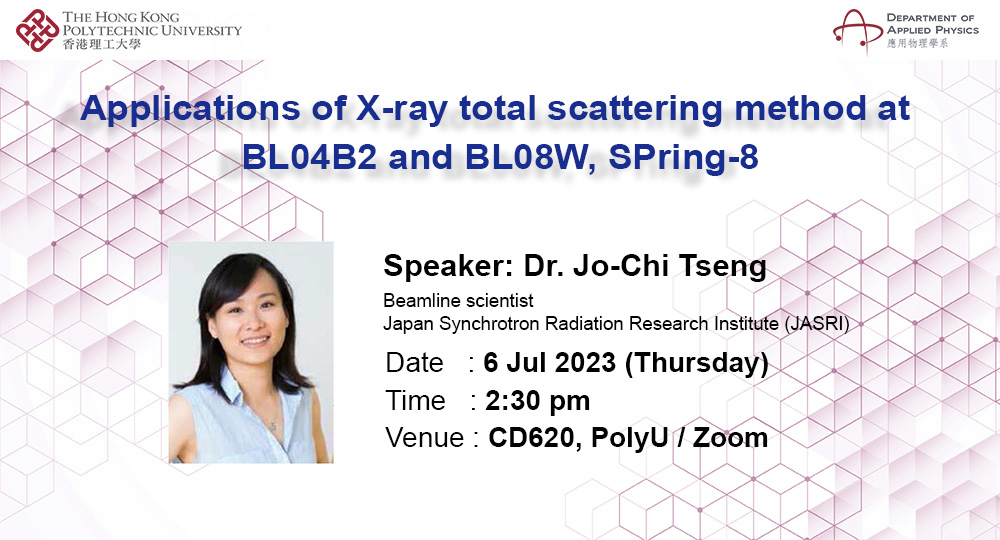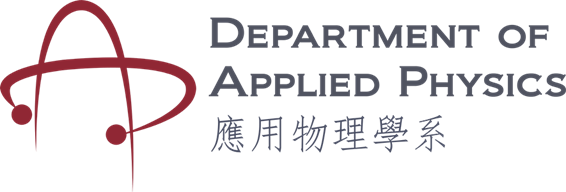AP Seminar - Applications of X-ray Total Scattering Method at BL04B2 and BL08W, SPring-8

-
Date
06 Jul 2023
-
Organiser
-
Time
14:30 - 15:30
-
Venue
CD620, 6/F, Wing CD, PolyU Map
Speaker
Dr. Jo-Chi Tseng
Summary
X-ray scattering is a versatile and widely used method for investigating the structural properties of materials at the atomic to macromolecular levels. It encompasses techniques such as Small-Angle X-ray Scattering (SAXS), Wide-Angle X-ray Scattering (WAXS), and Total Scattering (TS). By scanning samples across a wide range of angles, X-ray scattering can provide information about the distances between particles, even down to the distance between atoms. Among these techniques, the total scattering method is particularly limited to the use of high-energy radiation sources. This is because it requires retrieving fine structural information from high-q data through Fourier transform analysis. However, this method captures both Bragg and diffuse scattering, enabling the analysis of short-range and long-range order, as well as local atomic arrangements and structural disorder in materials. As a result, significant advancements have been made in characterizing not only crystalline materials but also amorphous materials, including glasses.
The high energy X-ray beamlines, BL08W and BL04B2 at SPring-8, stand out for X-ray total scattering method due to their very high flux under high X-ray energy (e.g., 60/15KeV). With a combination of a flat panel detector configuration, they facilitate the study of structural changes during the reaction process at a high frame rate in an operando approach. This capability provides valuable insights into the intermediates that cannot be detected through ex-situ experiments.
Recently, the total scattering method has been applied in understanding the synthesis mechanism of nanoparticles, the catalytic behavior of amorphous materials, and more. These applications involve monitoring the coordination and bond length changes of materials during reactions. By correlating local structural transformations with the chemical and physical properties of materials, valuable insights can be gained. Successful scientific cases have been shown in researches on Li/Na-ion batteries, hydrogenation processes, hydrothermal synthesis, and glass formation.
Keynote Speaker
Dr. Jo-Chi Tseng
Beamline Scientist
Japan Synchrotron Radiation Research Institute (JASRI)
Dr. Tseng received her B.S. and Master's degrees from National Cheng Kung University (Taiwan) and Ecole Nationale Supérieure de Céramique Industrielle (France) in 2010 and 2012, respectively. Subsequently, she pursued her Doctorate in Chemistry under the guidance of Professors Claudia Weidenthaler and Ferdi Schüth at the Max-Planck-Institut für Kohlenforschung in Germany. Since 2017, Dr. Tseng has been actively engaged in the field of advanced synchrotron techniques for in-situ X-ray diffraction and in-situ total scattering methods. She has worked as a post-doctoral researcher at the German Electron Synchrotron (DSEY) for two years before assuming the position of a beamline scientist at the Japan Synchrotron Radiation Research Institute (SPring-8/JASRI), where she continues her work to date. Her expertise lies in utilizing advanced synchrotron techniques to unravel and monitor the intricate properties of nanomaterials.




